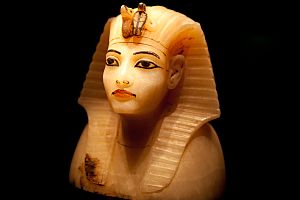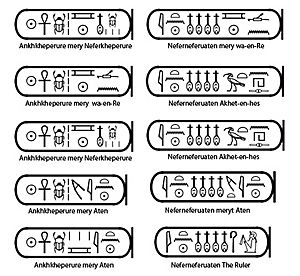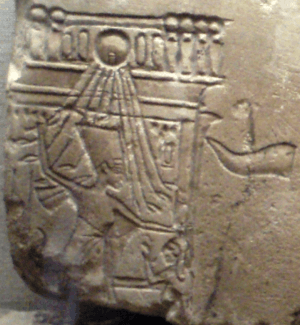Neferneferuaten facts for kids
Quick facts for kids Neferneferuaten |
|
|---|---|
| Pharaoh | |
| Reign | c 1334–1332 BC (Eighteenth dynasty of Egypt) |
| Predecessor | Smenkhkare |
| Successor | Tutankhamun |
| Consort | if Nefertiti: Akhenaten if Meritaten: Smenkhkare |
| Died | c. 1332 BC |
Ankhkheperure-Merit-Neferkheperure/Waenre/Aten Neferneferuaten was a female pharaoh who ruled ancient Egypt. She reigned near the end of the Amarna Period during the Eighteenth Dynasty. We know she was a woman because her name sometimes included female signs. Also, one version of her birth name (called a nomen or cartouche) had the phrase Akhet-en-hyes, which means "Effective for her husband."
Historians believe she was either Meritaten or, more likely, Nefertiti. If she was Nefertiti, some experts like Dr. Zahi Hawass think her rule saw the capital city move back to Thebes from Amarna.
Contents
A Mysterious Time in Egypt
The time when Neferneferuaten and Smenkhkare ruled is a bit confusing. It was a short period between Akhenaten's reign and when Tutankhamun became pharaoh. There isn't much evidence left from their time.
Neferneferuaten and Smenkhkare both used the same throne name, Ankhkheperure. Neferneferuaten also shared part of her birth name with Nefertiti. This makes it hard for historians to tell them apart.
Many older books thought Smenkhkare ruled after Akhenaten. But new discoveries have helped us understand more.
Here is a general timeline for the late Eighteenth Dynasty:
| King | Approx years |
|---|---|
| Akhenaten | 17 years |
| Ankhkheperure Neferneferuaten | 2 years |
| Ankhkheperure Smenkhkare | 2 years |
| Tutankhamun | 9 years |
| Ay | 4 years |
| Horemheb | 14 years |
After Neferneferuaten, her successor seems to have stopped her from having a proper king's burial. Many items meant for her were used for Tutankhamun's burial instead. Later, during Horemheb's reign, the names of pharaohs from the Amarna Period were removed from history. This is why it's so hard for experts to piece together what happened.
Ancient Records: Manetho
Manetho was an Egyptian priest who lived around 300 BC. He wrote a history of Egypt called Aegyptiaca. This work is now mostly lost, but parts of it were quoted by later writers. It's one of the few ancient records we have about the Amarna kings.
Manetho's summary of his work describes the pharaohs of the late Eighteenth Dynasty. He mentions a ruler named "Acencheres" who reigned for "12 years 1 month." Many believe "Acencheres" refers to Ankhkheperure, which is Neferneferuaten. This record suggests she ruled before Tutankhamun.
Important Clues and Evidence
Unlike Smenkhkare, we don't have any pictures of Neferneferuaten. We only know about her from writings. One important clue is the lid of a box (called Carter 001k) found in Tutankhamun's tomb. It has names of several rulers, including Akhenaten, Neferneferuaten, and Meritaten.
Another very important clue is a long inscription found in the tomb of Pairi (TT139). A scribe named Pawah wrote it in Neferneferuaten's third year as ruler. This writing shows that Neferneferuaten was starting to allow the worship of the god Amun again. This was a big change from Akhenaten's time, who only wanted people to worship the Aten. This suggests Neferneferuaten was the first ruler to bring back the old religion, not Tutankhamun.

Several stone carvings (called stelae) show a king and another person, often wearing a king's crown, in friendly poses. These carvings are not finished or have been damaged.
- One unfinished carving (#17813, Berlin) shows two royal figures. One wears the double crown of a king, and the other wears a crown similar to the one Nefertiti wears in her famous bust, but it's a "blue crown" worn by a king. This might mean Nefertiti was a co-ruler.
- Another carving (Berlin 25574) shows Akhenaten and Nefertiti. There are spaces for four names, enough for two kings. This suggests Nefertiti might have become a co-ruler later.
- The Coregency Stela (UC.410) has Akhenaten's name next to Neferneferuaten's. Neferneferuaten's name was carved over Nefertiti's name. This strongly suggests Nefertiti became King Neferneferuaten.
Many items in Tutankhamun's tomb (KV62) were first made for Neferneferuaten. These include a gold chest piece, parts of his stone sarcophagus, royal statues, and even his famous gold mask. This shows that her burial items were reused for Tutankhamun.
A Female King
For a long time, people thought Smenkhkare was a co-ruler with Akhenaten. They believed he later changed his name to Ankhkheperure Neferneferuaten. Another idea was that Nefertiti was King Neferneferuaten.
In the 1970s, Egyptologist John Harris noticed that some versions of Neferneferuaten's name had female signs. This, along with a feminine-looking statue found in Tutankhamun's tomb, suggested Neferneferuaten was a woman.
In 1988, James P. Allen showed that Smenkhkare and Neferneferuaten were likely two different people. He found that Neferneferuaten's throne name (prenomen) often included a phrase like "desired of Wa en Re," which referred to Akhenaten. Smenkhkare's name did not have this. Also, Neferneferuaten's name often had a feminine "t" sound.
Later, Marc Gabolde found that some items from Tutankhamun's tomb, originally for Neferneferuaten, said "effective for her husband." This confirmed she was a female ruler. These special phrases (epithets) helped scholars tell the two rulers apart.
Did She Rule Alone?
Allen also found that Neferneferuaten's epithets changed over time. At first, they strongly linked her to Akhenaten, suggesting she was his co-ruler. Later, some epithets like "desired of the Aten" or "The Ruler" appeared without any mention of Akhenaten. This suggests she might have ruled alone for a period after Akhenaten died.
The fact that two kings used the same throne name, Ankhkheperure, is unusual. Allen suggested that Neferneferuaten used her epithets to show she was Akhenaten's chosen successor. This might mean there was some disagreement about her becoming pharaoh. Smenkhkare might have used the same name to challenge her claim to the throne.
Who Was Neferneferuaten?
Most Egyptologists now agree that Neferneferuaten was a female king, separate from Smenkhkare. Many also believe she was a co-ruler with Akhenaten. The main question now is: who was she? The debate usually comes down to Nefertiti or Meritaten.
Nefertiti
Nefertiti was an early candidate for King Neferneferuaten. She was Akhenaten's powerful wife and was often shown doing kingly things, like defeating enemies. This made her a strong candidate to become pharaoh after Akhenaten.
For a long time, people thought Nefertiti died around Akhenaten's 12th year of rule. But in 2012, an inscription was found from Akhenaten's 16th year. It showed Nefertiti was still alive and was still the Great Royal Wife. This means she was queen just before Akhenaten's last year. This new information makes it less likely she was a co-ruler for a long time.
Some experts, like Aidan Dodson, still think Neferneferuaten (Nefertiti) might have ruled with Tutankhamun. But others disagree, saying there isn't enough proof.
The Coregency Stela (UC 410) is important here. Neferneferuaten's name was carved over Nefertiti's name on it. If Nefertiti's image was simply updated with a new crown, it would strongly suggest she became king. If her whole image was replaced, it would mean someone else became king. The carving is damaged, so it's hard to be sure. But replacing Nefertiti's name with a king's name still points to Nefertiti becoming the new king.
Meritaten
Meritaten was another possible candidate for Neferneferuaten. She was Akhenaten's daughter and later became Smenkhkare's wife. Some historians thought she might have ruled briefly after Akhenaten's death.
However, the main problem with Meritaten being Neferneferuaten is that Meritaten is well-known as Smenkhkare's wife and queen. If she later became king, it would mean she stepped down from being a king to being a king's wife again, which seems unlikely.
Also, since Nefertiti was confirmed to be alive in Akhenaten's 16th year, it makes Meritaten less likely to be the female pharaoh Neferneferuaten.
Neferneferuaten-tasherit
In 2006, James Allen suggested that Neferneferuaten was Akhenaten and Nefertiti's fourth daughter, Neferneferuaten-tasherit. This idea is based on her name. Her name already included "Neferneferuaten." The "tasherit" part means "the lesser" or "the younger," which might have been dropped when she became pharaoh.
The main issue with this idea is her age. She was probably around 10 years old when Akhenaten died. While Tutankhamun became pharaoh at a young age, a 10-year-old girl ruling alone seems unlikely to many.
Tutankhamun's Burial and Neferneferuaten

Many items in Tutankhamun's tomb were originally made for Neferneferuaten. This includes his famous gold mask, his middle coffin, and many other precious objects. In 2015, Nicholas Reeves showed that an earlier name on Tutankhamun's gold mask was "Ankheperure mery-Neferkheperure" (Ankheperure beloved of Akhenaten). This means the mask was first made for Neferneferuaten.
This suggests that Neferneferuaten might have been removed from power, or perhaps she was buried with different royal items. It also means that Tutankhamun took over as king after her.
Conclusion
We don't know much for sure about the life and rule of Ankhkheperure Neferneferuaten. Most experts agree she was a woman and a separate person from Smenkhkare. Many also believe she was a co-ruler with Akhenaten for a time.
Based on the Pairi inscription, it seems she ruled alone for a period. This inscription also mentions an Amun temple in Thebes, suggesting that the old religion was being brought back during her reign. Since many of her burial items were used for Tutankhamun, it seems she was not given a proper pharaoh's burial by her successor. We don't know why this happened.
Because so much evidence from the Amarna period was destroyed by later kings, the exact details of these events might never be fully known. The clues we have often suggest things but don't always prove them. For example, the various carvings strongly suggest a female co-ruler, but they don't clearly say who she was.
See also
 In Spanish: Neferneferuatón para niños
In Spanish: Neferneferuatón para niños




